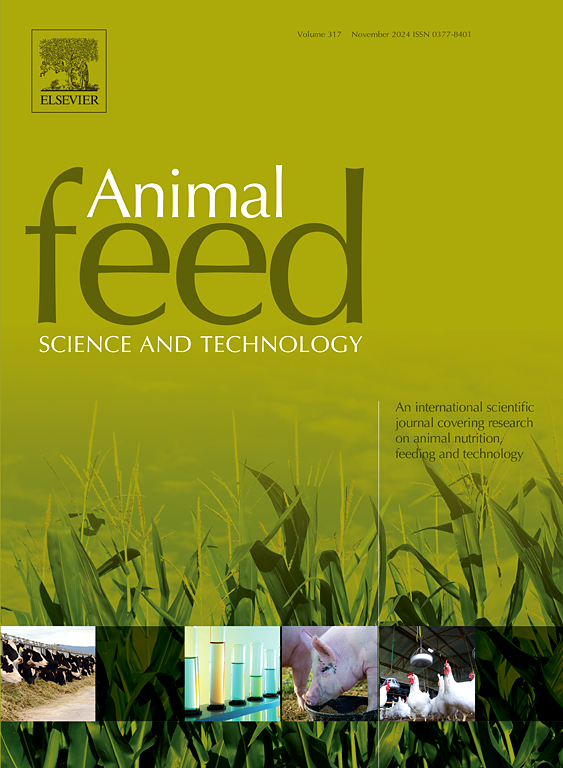探索枯萎和不同类型添加剂的组合,以提高高原紫花苜蓿的青贮质量:发酵质量、营养价值、分子结构特征和瘤胃降解性
IF 2.7
2区 农林科学
Q1 AGRICULTURE, DAIRY & ANIMAL SCIENCE
引用次数: 0
摘要
本研究旨在探讨枯萎预处理和不同类型的贮藏添加剂对高原紫花苜蓿青贮质量、营养价值、分子结构特征和瘤胃降解性的交互作用。总共 48 袋紫花苜蓿牧草被随机分配到 8 个处理中的一个,采用 2 × 4 的因子排列(6 个重复袋/处理)。在一公斤未枯萎(72% 水分)或已枯萎(60% 水分)的紫花苜蓿牧草中接种酸性盐、乳酸菌、有机酸或不加添加剂(对照)。我们的研究结果表明,枯萎过程提高了乳酸和粗蛋白含量,降低了青贮饲料中的 NH3-N 含量,并提高了其体外 DM 消化率(所有 P < 0.05)。萎蔫处理使酰胺 I/II 比率提高了 31.7%,总碳水化合物 II 区域提高了 19.6%(均为 P < 0.05)。用乳酸菌接种预萎蔫苜蓿可进一步降低 pH 和 NH3-N 水平,提高青贮饲料中的乳酸水平和 DM 消化率(均为 P < 0.05)。添加有机酸降低了青贮的 pH 值,提高了乳酸、粗蛋白、淀粉含量和 DM 消化率(均为 P <0.05)。相关分析表明,酰胺 I/II 峰高比和 TC2 面积越大的青贮饲料可消化的营养物质越多,DM 消化率越高。总之,枯萎预处理与乳酸菌接种剂相结合是提高高原苜蓿青贮质量和养分利用率的有效方法。非侵入式光谱仪有可能揭示苜蓿青贮的分子光谱特征并预测养分的可用性。本文章由计算机程序翻译,如有差异,请以英文原文为准。
Exploring the combination of wilting and different types of additives to improve silage quality of highland alfalfa: Fermentation quality, nutritional values, molecular structural features, and ruminal degradability
The study aimed to explore the interaction between wilting pretreatment and different types of ensiling additives on silage quality, nutritional value, molecular structural features, and ruminal degradability of highland alfalfa. A total of 48 bags of alfalfa forage were randomly assigned into one of eight treatments in a 2 × 4 factorial arrangement (6 replication bags/treatment). One kg of either unwilted (72 % moisture) or wilted (60 %) alfalfa forage was inoculated with acidic salt, lactic acid bacteria, organic acids, or left without additive (control). Our results indicated that the wilting process increased lactic acid and crude protein levels, decreased the NH3-N level in silage, and increased its in vitro DM digestibility (all P < 0.05). The wilting treatment increased the amide I/II ratio by 31.7 % and the total carbohydrate II regions by 19.6 % (both P < 0.05). Inoculating pre-wilted alfalfa with lactic acid bacteria further reduced the pH and NH3-N levels and increased the lactic acid level and DM digestibility in silage (all P < 0.05). The addition of organic acids decreased silage pH and increased lactic acid, crude protein, and starch contents, and DM digestibility (all P < 0.05). Correlation analysis indicated that silage with a higher amide I/II peak height ratio and TC2 areas had more digestible nutrients and higher DM digestibility. In conclusion, wilting pretreatment combined with lactic acid bacteria inoculant is an effective approach to improve quality and nutrient availability of highland alfalfa silage. The non-invasion spectrometer has the potential to reveal the molecular spectral characteristics of alfalfa silage and predict nutrient availability.
求助全文
通过发布文献求助,成功后即可免费获取论文全文。
去求助
来源期刊

Animal Feed Science and Technology
农林科学-奶制品与动物科学
CiteScore
6.00
自引率
6.20%
发文量
266
审稿时长
3 months
期刊介绍:
Animal Feed Science and Technology is a unique journal publishing scientific papers of international interest focusing on animal feeds and their feeding.
Papers describing research on feed for ruminants and non-ruminants, including poultry, horses, companion animals and aquatic animals, are welcome.
The journal covers the following areas:
Nutritive value of feeds (e.g., assessment, improvement)
Methods of conserving and processing feeds that affect their nutritional value
Agronomic and climatic factors influencing the nutritive value of feeds
Utilization of feeds and the improvement of such
Metabolic, production, reproduction and health responses, as well as potential environmental impacts, of diet inputs and feed technologies (e.g., feeds, feed additives, feed components, mycotoxins)
Mathematical models relating directly to animal-feed interactions
Analytical and experimental methods for feed evaluation
Environmental impacts of feed technologies in animal production.
 求助内容:
求助内容: 应助结果提醒方式:
应助结果提醒方式:


